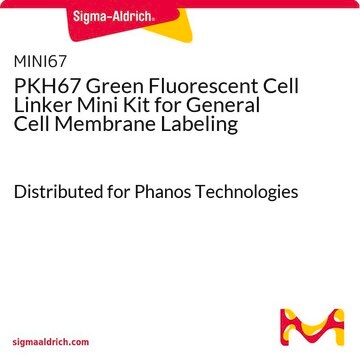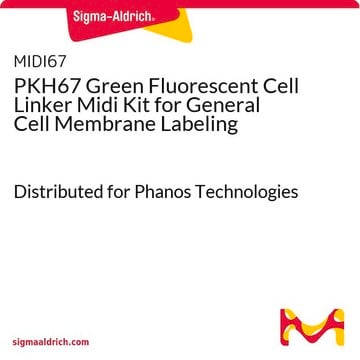Yes, Product PKH67 would be suitable for this application. In this paper, both Products PKH26 and PKH67 are used in a similar application:
https://www.ncbi.nlm.nih.gov/pmc/articles/PMC5679712/
¥226,000
おすすめの製品
品質水準
包装
pkg of 1 kit
保管条件
protect from light
蛍光検出
λex 490 nm; λem 502 nm (PKH67 dye)
検出方法
fluorometric
輸送温度
ambient
保管温度
room temp
アプリケーション
- トリプルネガティブ乳がん病態の細胞から放出されたエキソソームを標識し、さらに調べることに。[1]
- アポトーシス細胞を標識するために。[2]アポトーシス細胞の結合および内在化の両方における ανβ5受容体の役割を研究するために。[3]
- 蛍光画像法で。[4]
PKH1およびPKH2を用いたin vivo 研究では、蛍光の消失が遅いことが観察されています。 この挙動は緑色細胞リンカ-色素に特徴的ですが、赤色細胞リンカ-色素には特徴的でないことから、PKH67も同様の性質を示すと考えられます。非分裂細胞におけるin vitro細胞膜維持率とin vivo蛍光半減期との相関から、PKH67のin vivo蛍光半減期は10~12日と予測されます。同程度の半減期を持つ他の緑色蛍光リンカ-色素は、1-2カ月間のin vivo リンパ球およびマクロファ-ジ輸送の観察に使用されていることから、PKH67も適度な期間のin vivo トラッキング研究に使用できると考えられます。
関連事項
法的情報
キットの構成要素のみ
- Diluent C 6 x 10
- PKH67 Cell Linker in ethanol .5 mL
シグナルワード
Danger
危険有害性情報
危険有害性の分類
Eye Irrit. 2 - Flam. Liq. 2
保管分類コード
3 - Flammable liquids
引火点(°F)
57.2 °F - closed cup
引火点(℃)
14 °C - closed cup
適用法令
試験研究用途を考慮した関連法令を主に挙げております。化学物質以外については、一部の情報のみ提供しています。 製品を安全かつ合法的に使用することは、使用者の義務です。最新情報により修正される場合があります。WEBの反映には時間を要することがあるため、適宜SDSをご参照ください。
毒物及び劇物取締法
キットコンポーネントの情報を参照してください
PRTR
キットコンポーネントの情報を参照してください
消防法
キットコンポーネントの情報を参照してください
労働安全衛生法名称等を表示すべき危険物及び有害物
キットコンポーネントの情報を参照してください
労働安全衛生法名称等を通知すべき危険物及び有害物
キットコンポーネントの情報を参照してください
カルタヘナ法
キットコンポーネントの情報を参照してください
Jan Code
キットコンポーネントの情報を参照してください
この製品を見ている人はこちらもチェック
資料
PKH dyes are easy to use and achieve stable, uniform, and reproducible fluorescent labeling of live cells. PKH dyes are non-toxic membrane stains which produce high signal to noise ratio.
Lipophilic cell tracking dyes enable cancer biologists to track tumor and immune cell functions both in vitro and in vivo. Read the article to choose a right membrane dye kit for cell tracking and proliferation monitoring.
Optimal staining is a key component for studying tumorigenesis and progression. Learn useful tips and techniques for dye applications, including examples from recent studies.
PKH and CellVue® Fluorescent Cell Linker Kits provide fluorescent labeling of live cells over an extended period of time, with no apparent toxic effects.
-
I mark mitochondria for injection with PKH26 Red Fluorescent Cell Linker Kit for General Cell Membrane Labeling. I want to use another dye to mark another type of mitochondria and inject them together in the same fish egg. Is PKH67 ok for this like PKH26?
1 回答-
役に立ちましたか?
-
-
What can be the alternative for removing excess dye after labeling of exosomes using PKH67 dye apart from ultracentrifugation?
1 回答-
Excess dye is bound to serum or albumin which is added to the cell/dye mixture as a stop reaction. The recommended clean up or dye removal is by standard centrifugation (400 x g for 10 minutes, wash, and repeat). See the Product Information Sheet, page 3, bullet point 8 for more information:
https://www.sigmaaldrich.com/deepweb/assets/sigmaaldrich/product/documents/984/984/pkh67glbul.pdfAlternate methods for excess dye removal have not been investigated.
役に立ちましたか?
-
-
Can we remove the excess PKH67 DYE used for the labeling of exosomes using exosome spin column rather than ultracentrifugation.
1 回答-
The recommended exosome labeling protocol has been optimized to assure the best possible results. The use of exosome spin columns with the PKH and CellVue products has not been validated. See below for a link to our exosome labeling protocol. A spin column method may not offer the best results.
役に立ちましたか?
-
-
Will Product PKH67, Green Fluorescent Cell Linker Kit, stain dead cells?
1 回答-
As long as the cell has an intact membrane, the PKH76 dye can label the cell.
役に立ちましたか?
-
-
What is the difference between Green Fluorescent Cell Linker Kits PKH2 and PKH67?
1 回答-
PKH2 was one of the early PKH dyes. The PKH67 dye has a longer aliphatic tail. There is reduced cell-celldye transfer for PKH67 as compared with PKH2.
役に立ちましたか?
-
-
What method of fixation can be used for tissue/cells with the PKH Fluorescent Cell Linker Kit for General Cell Membrane Labeling dyes?
1 回答-
A protocol for visualization of tissue sections can be found in the technical bulletin. For visualization of stained cells by immunofluorescence or flow cytometry, the cells can be fixed in 2% paraformaldehyde for 15 minutes. The use of other organic solvents will extract the dye from the cells. If internal labeling is desired, the cells can be permeabilized with saponin (50-75 μg/mL). Here is the link to the Troubleshooting Guide.
役に立ちましたか?
-
-
What is the Department of Transportation shipping information for this product?
1 回答-
Transportation information can be found in Section 14 of the product's (M)SDS.To access the shipping information for this material, use the link on the product detail page for the product.
役に立ちましたか?
-
-
What is the excitation and emission spectra for Product PKH67GL, Green Fluorescent Cell Linker Kit?
1 回答-
The spectra can be found on the product insert.The product has a maximum excitation at 490 nm and maximum emission at 502 nm.
役に立ちましたか?
-
-
How many cells can be stained with Product PKH67GL, Green Fluorescent Cell Linker Kit?
1 回答-
This kit can stain 50 × 107 cells if used as directed (1 × 107 cells stained with 2 × 10-6 M PKH67).
役に立ちましたか?
-
-
When using Product PKH67GL, PKH67 Green Fluorescent Cell Linker Kit for General Cell Membrane Labeling, how long will the cells remain stained after treatment?
1 回答-
Labeled cells that have been washed can be visualized in culture up to 100 days after staining (for non-dividing cells). The dye itself is stable and will divide equally when the cells divide. After staining with PKH dyes, you can observe as many as 8 divisions depending on how brightly the cells were stained initially and the amount of surface area on the cells. Most commonly, 4-6 divisions can be visualized.
役に立ちましたか?
-
アクティブなフィルタ
ライフサイエンス、有機合成、材料科学、クロマトグラフィー、分析など、あらゆる分野の研究に経験のあるメンバーがおります。.
製品に関するお問い合わせはこちら(テクニカルサービス)













